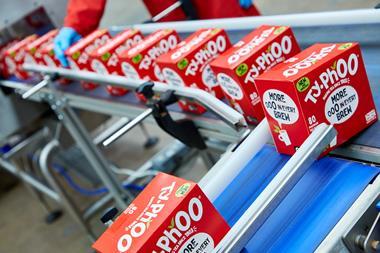Simon Brocket, vice-president for human resources at Coca-Cola Enterprises, on the benefits of a cohesive leadership culture
In the summer of 2000, Coca-Cola Enterprises undertook a survey to identify the strengths and weaknesses of the organisation and the level to which people understood the company’s goals and objectives.
The findings revealed some great strengths, particularly in teamwork. However, shortcomings were also identified. The most important issues reflected the absence of a shared vision of leadership and a lack of cohesion in the executive team.
I wasn’t particularly surprised by this because after CCE’s acquisition of the Coca-Cola Cadbury Schweppes bottling business it had embarked on massive changes. Almost all our teams and structures had been rearranged, managers had new roles; in fact, no job was left untouched.
Our executive team began preparing to re-examine our leadership, culture and work processes - not an easy task when you have 5,000 staff in 23 UK sites to consider.
To provide support and expertise and facilitate the organisational transition to one in which all staff were working with a shared set of values towards a shared vision of the company’s future, we turned to performance development consultancy Lane4.
Initial interviews between Lane4 consultants and CCE executives revealed that employees’ commitment and trust was influenced by their view of the cohesion of the executive team. At the time there was a lack of team spirit at the top, coupled with a strong sense of functional ownership.
As with many other successful blue-chip companies, executives had fallen into the trap of working too much in isolation. While these individuals were talented and goal oriented, and very aware of the company’s broader commercial objectives, the reasons for commercial decisions being made were not fully communicated throughout the organisation.
In conjunction with Lane4, we embarked on a programme that would build on the inherent successful leadership behaviours (talented and goal oriented), but would also address organisational issues that were contributing to the lack of understanding and confidence in overall corporate goals and senior management.
The starting point was the identification of the desired outcome of the programme. This was the development of a cohesive leadership culture that would foster organisational commitment and achievement.
To ground the idea of a cohesive
leadership culture in day-to-day activities, Lane4 identified seven leadership behaviours that CCE leaders should focus on to help engender organisational trust and commitment, under the titles of vision, support and challenge.
The first comprises identifying and articulating a vision, being an appropriate role model and fostering acceptance for group goals.The second involves providing individualised support and contingent
reward feedback, while the challenges are to set high performance expectations and provide intellectual stimulation.
The three main benefits from building on these seven aims include winning greater loyalty and trust in leaders, gaining greater organisational commitment and increased staff job satisfaction.
To help develop the seven behaviours, Lane4 devised a programme of leadership team meetings, topic-centred workshops, individual coaching, upward feedback and applied learning projects. Following the implementation of this programme, new figures show that executive team cohesion is up by 70%. This has resulted in employees’ trust in leadership increasing by 30% and commitment rising 40%, while workforce turnover has fallen dramatically since 2000.
The latest data indicates that we have strong foundations for a coaching culture - 97% of our managers report that they now have the knowledge and skills to coach, 90% attribute improvements in their own and their team’s performance to coaching and more than 70% say more coaching is taking place today than took place 12 months ago. In terms of leadership behaviours, we have seen baseline measures of vision, support and challenge move upwards by almost 20% since April 2002.
In my opinion, building leadership capability from the top of CCE and introducing a coaching culture has been key to balancing our effort so that we can focus on both the ‘what’ and the ‘how’.
We have great people in our business and it is our duty to help them realise their full potential. By doing this, we ensure that we can successfully embrace the business challenges that lie ahead.
In the summer of 2000, Coca-Cola Enterprises undertook a survey to identify the strengths and weaknesses of the organisation and the level to which people understood the company’s goals and objectives.
The findings revealed some great strengths, particularly in teamwork. However, shortcomings were also identified. The most important issues reflected the absence of a shared vision of leadership and a lack of cohesion in the executive team.
I wasn’t particularly surprised by this because after CCE’s acquisition of the Coca-Cola Cadbury Schweppes bottling business it had embarked on massive changes. Almost all our teams and structures had been rearranged, managers had new roles; in fact, no job was left untouched.
Our executive team began preparing to re-examine our leadership, culture and work processes - not an easy task when you have 5,000 staff in 23 UK sites to consider.
To provide support and expertise and facilitate the organisational transition to one in which all staff were working with a shared set of values towards a shared vision of the company’s future, we turned to performance development consultancy Lane4.
Initial interviews between Lane4 consultants and CCE executives revealed that employees’ commitment and trust was influenced by their view of the cohesion of the executive team. At the time there was a lack of team spirit at the top, coupled with a strong sense of functional ownership.
As with many other successful blue-chip companies, executives had fallen into the trap of working too much in isolation. While these individuals were talented and goal oriented, and very aware of the company’s broader commercial objectives, the reasons for commercial decisions being made were not fully communicated throughout the organisation.
In conjunction with Lane4, we embarked on a programme that would build on the inherent successful leadership behaviours (talented and goal oriented), but would also address organisational issues that were contributing to the lack of understanding and confidence in overall corporate goals and senior management.
The starting point was the identification of the desired outcome of the programme. This was the development of a cohesive leadership culture that would foster organisational commitment and achievement.
To ground the idea of a cohesive
leadership culture in day-to-day activities, Lane4 identified seven leadership behaviours that CCE leaders should focus on to help engender organisational trust and commitment, under the titles of vision, support and challenge.
The first comprises identifying and articulating a vision, being an appropriate role model and fostering acceptance for group goals.The second involves providing individualised support and contingent
reward feedback, while the challenges are to set high performance expectations and provide intellectual stimulation.
The three main benefits from building on these seven aims include winning greater loyalty and trust in leaders, gaining greater organisational commitment and increased staff job satisfaction.
To help develop the seven behaviours, Lane4 devised a programme of leadership team meetings, topic-centred workshops, individual coaching, upward feedback and applied learning projects. Following the implementation of this programme, new figures show that executive team cohesion is up by 70%. This has resulted in employees’ trust in leadership increasing by 30% and commitment rising 40%, while workforce turnover has fallen dramatically since 2000.
The latest data indicates that we have strong foundations for a coaching culture - 97% of our managers report that they now have the knowledge and skills to coach, 90% attribute improvements in their own and their team’s performance to coaching and more than 70% say more coaching is taking place today than took place 12 months ago. In terms of leadership behaviours, we have seen baseline measures of vision, support and challenge move upwards by almost 20% since April 2002.
In my opinion, building leadership capability from the top of CCE and introducing a coaching culture has been key to balancing our effort so that we can focus on both the ‘what’ and the ‘how’.
We have great people in our business and it is our duty to help them realise their full potential. By doing this, we ensure that we can successfully embrace the business challenges that lie ahead.


















No comments yet